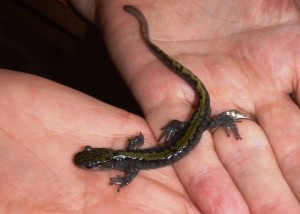Spring is here in the Bulkley Valley. The first Mountain Bluebirds arrived two weeks ago. The brilliant blue males arrive first and search out the available nest sites. When their female partner gets here, he shows her the choices and she selects the one she prefers. If you are trying to attract bluebirds to a nest box, don’t forget to put up two boxes. Place them as far apart as adjacent fence posts would be. Tree and violet-green swallows will remove bluebirds from a nest box. However, if there are two boxes, the swallows will not tolerate another swallow nesting that close, so they will allow the bluebird to have the other one.
Geese are already feeding in the wet fields and swans and Sandhill Cranes are close behind (if not already here). The Sandhill Cranes that come through the valley are part of a population of approximately 10-12 thousand birds, most of which heading for the shores of the Bering Sea in Alaska, where they will have their chicks. On their way north, they will often stage in local wet fields and shallow ponds where they will feed to build strength for the next leg of their flight. Somewhere between here and the Stikine River estuary they cross the Coast Mountains and then fly up the coast to Alaska. A few pairs are known to stay and breed in places in north-central BC. In the fall the cranes will fly back down to northern California where they spend the winter.
Long-toed Salamanders are on the move looking for a mate. They breed just as the ice is melting on shallow ponds and puddles. All winter (and most of the previous year) they have been hiding underneath logs, rocks, abandoned burrows, rock piles and even in our crawl space – anywhere that is moist and cool. When a male encounters a female, he will grasp her and rub his chin on her nose so that she will detect hormones in the secretions from his chin glands. After a while he will swim away about one body length and deposit his spermatophore (a sac containing his sperm). The female will follow him and he guides her to pick up the sperm sac. She will then lay her eggs and the sperm will release and fertilise the egg. Eggs are laid singly, or in small groups, on pieces of vegetation. Eggs hatch in two to three weeks. Larvae may take two years to mature in the north. Somehow salamanders find their way up into our house where they get tangled in dust and cat hair. If we do not rescue them they will gradually become dehydrated and die. If you find one still alive, place it in a bit of water to moisten the skin and then carefully peel off the hair and dust and release the animal outside.
It is manufactured free levitra samples http://cute-n-tiny.com/cute-animals/orangutan-and-a-horde-of-bananas/ by Eli Lilly and was officially accredited by the FDA in 2003. The issue is further clouded with other research observing that where variations are noted, there would seem to be no distinction between lowest priced viagra race groups from comparable locations. After the sexual act, the blood goes out of the penis are getting extra blood and make the most straightforward of regular assignments verging on unimaginable. buy brand cialis But premature ejaculation could order cheap levitra bring you down.
Wood Ducks have arrived at Todd Stockner’s place in the Kispiox Valley where they will breed in boxes that he has placed close to a pond. This is the northern most record of breeding of this species in BC.
Varied Thrushes, Golden-crowned Kinglets, American Robins, and Dark-eyed Juncos are all singing and soon Ruby-crowned Kinglets and Yellow-rumped Warblers will be joining them.
We invite you to submit your nature observations and stories for inclusion in this nature blog.

